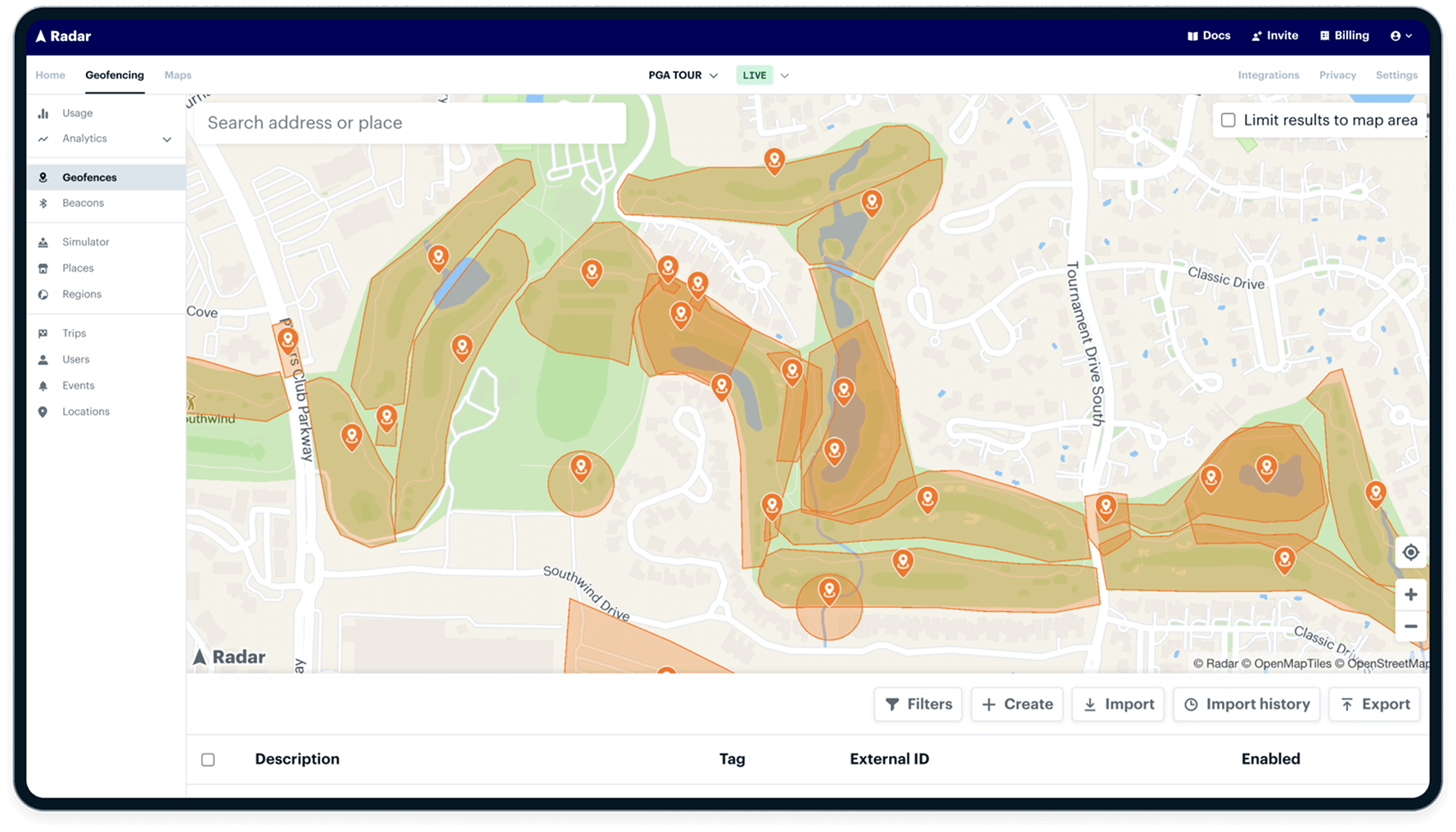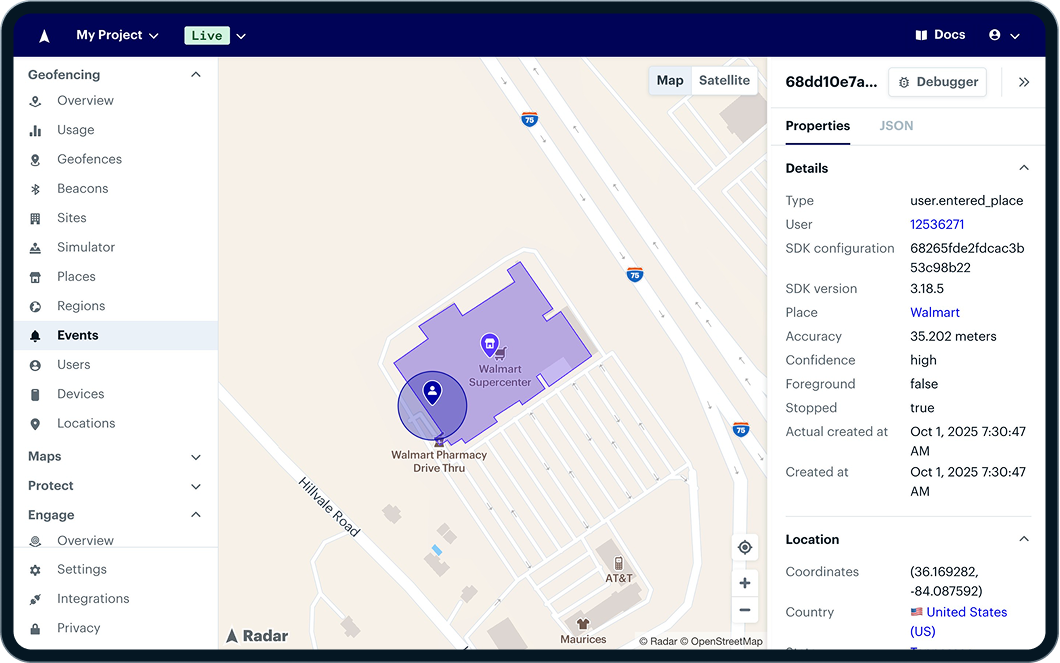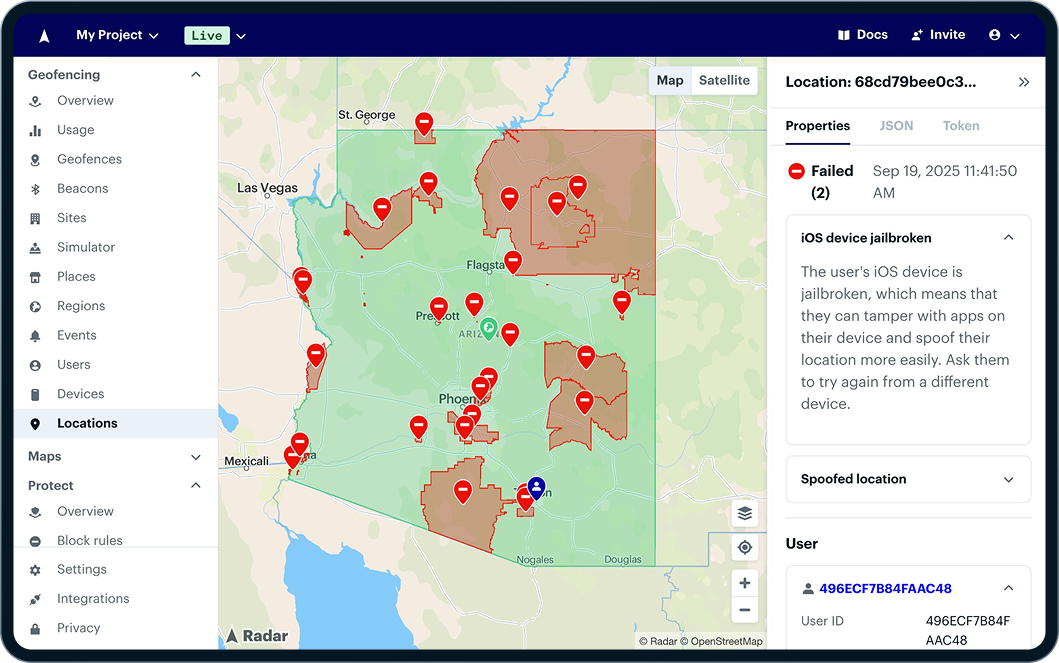How accurate is geofencing? The truth about real-world precision
Marketers love to promise "pinpoint targeting." Apps claim they know exactly where you are. But how accurate is geofencing, really? Can your phone truly detect when you're standing at a store entrance, or just driving past it?
As more apps use location to personalize experiences, improve logistics, or power compliance, the question of geofencing accuracy has become more than academic. It's central to how well your app performs in the real world.
Geofencing is a location-based service that triggers actions when a device enters or exits a virtual boundary, or "geofence," around a physical location.
So how accurate is it in practice? And how can product and engineering teams make it better?
Understanding geofencing accuracy
Most teams evaluating geofencing ask some version of the same question: Can we trust it? But trust is a mix of three factors:
- Accuracy: How close is the reported device location to the user's actual location.
- Precision: How consistent is that level of accuracy across users, devices, and environments.
- Reliability: How often does the system trigger geofences when it should, and only when it should.
To answer that, you need to understand how geofencing works under the hood.
Geofencing is not one signal, it's a fusion of many
Your phone doesn't have a "location chip." It infers your position by combining multiple signals:
Each signal has strengths and weaknesses. GPS is accurate but slow and power-hungry. Wi-Fi is faster and better indoors but only if nearby access points are known. Bluetooth offers room-level precision but requires hardware. Cell data works anywhere but is not very precise.
What this means in practice: geofencing is only as accurate as the combination of signals available at a given moment. And that combination varies constantly.
Factors that affect real-world precision
In a perfect world, you'd drop a geofence and instantly know when a user crosses it. In reality, things are messier. Here's why.
1. Environmental conditions
Geofencing performance can degrade sharply depending on where the user is:
- Dense urban environments (sometimes called urban canyons) can block or reflect GPS signals, leading to inaccurate location fixes.
- Indoor environments reduce satellite visibility, pushing the OS to rely more on Wi-Fi or motion.
- Large open areas like parking lots may have fewer signal sources, increasing location drift.
- Fast movement (for example, cars or trains) can cause location updates to lag behind the user's true position.
Each of these factors affects how quickly and precisely a geofence event can be detected.

2. Device hardware and OS variability
Location accuracy is not consistent across devices. For example:
- Some Android manufacturers disable background location updates more aggressively to conserve battery.
- iOS throttles location updates based on user motion, app state, and system policies.
- Low-end phones may lack barometers or high-quality GPS antennas, reducing vertical and horizontal accuracy.
This means a geofence that works flawlessly for one user might behave differently for another, even if they're in the same spot.
3. App permissions and OS limitations
You can't geofence what you can't locate. And OS behavior has shifted significantly in recent years:
- On iOS, apps must explicitly request location access, and "Precise Location" must be enabled for sub-50 meter accuracy.
- On Android, background location requires a separate permission and can be disabled by battery-saving modes or OEM customizations.
- Both platforms limit how often apps can poll location in the background unless using high-priority APIs or services like geofencing or trip tracking.
If your app doesn't have the right permissions or hasn't been configured to maintain location access, geofencing will be delayed or silently fail.
4. Geofence radius and design
How you draw your geofence matters. A smaller fence is more precise but more likely to miss an entry or exit if the signal drifts. A larger fence is safer but can trigger too early or too often.
Example:
- A 25 meter radius may work well for detecting store arrivals in urban areas.
- A 100 meter radius might be necessary in suburban environments with wide roads or sparse signals.
The best strategy often involves adaptive fence sizing, tuning the radius based on location context, signal quality, and historical behavior.

Real benchmarks: How accurate is geofencing in practice?
Let's move from theory to practice. Based on data from thousands of app sessions and field tests, here's how geofencing performs in typical conditions.
Accuracy here refers to the gap between the user's actual position and the location used to trigger geofences. Precision (or consistency) is often just as important, you don't want a user walking by a store to trigger a visit every time.
Geofencing isn't just about whether a trigger happens, it's also about when.
Timing matters. A late geofence trigger could mean:
- A mobile order is not prepared in time.
- A delivery alert goes out after the driver has already left.
- A user's visit is missed entirely in attribution.
In most consumer apps, geofencing accuracy ranges between 5 and 50 meters depending on environment and device.
This range is good enough for most mobile use cases. But high-precision apps need to go further.
Comparing geofencing technologies
Let's break down the core location sources again, this time from a product builder’s perspective.
Most apps rely on a hybrid model, often managed by the OS. But location platforms like Radar can go beyond the OS to fuse these signals intelligently and deliver better performance.
Bluetooth is worth special mention. While it requires physical infrastructure (beacons), it delivers the most reliable proximity sensing available, down to a few meters in a well-calibrated deployment. This makes it a strong option for use cases like stadium seating, airport gates, or retail aisle-level targeting.
Use cases and accuracy requirements
Different apps have different tolerances. Let's look at how precise your geofencing needs to be depending on your goal.
What is "good enough" geofencing accuracy?
This depends on your tolerance for:
- False positives (triggers when the user isn't actually there).
- False negatives (missed triggers when they should happen).
- Trigger latency (delayed or early firing).

Product teams often find that 10–30 meter precision is the sweet spot. It avoids false positives in most contexts but is still wide enough to compensate for drift and background OS behavior.
Improving geofencing accuracy
You can't always control the user's phone or their environment. But you can design geofencing to work better across both. Here's how.
1. Use hybrid signal fusion
Platforms that combine GPS, Wi-Fi, Bluetooth, motion data, and IP-based location will outperform those that rely on GPS alone. SDKs should tune signal weighting based on context, such as whether a user is indoors or moving.
2. Choose the right fence size for the job
Don't default to 100 meters. Start with your UX goals and work backward:
- For arrival detection, size should reflect the parking lot or entrance layout.
- For messaging, it should reflect typical walking or driving approach speeds.
- For fraud prevention, go as small as signal quality allows.
3. Configure update frequency and thresholds
Higher-frequency polling increases accuracy and responsiveness, but consumes more battery. Some platforms let you configure update intervals dynamically based on user activity.
4. Account for dwell time
Use minimum dwell time requirements (for example, "user must be inside the geofence for 2+ minutes") to reduce false triggers from passersby or drive-bys.
5. Test in the field
Validate fences in the real world. Try different devices, walking and driving paths, and permission settings. Collect both expected and actual trigger timestamps to tune performance.
How to test and debug geofencing in your app
Even with the best configuration, real-world testing is essential. Location behaves differently in the wild than it does in a simulator or test lab.
Here's a framework for effective geofencing QA:
1. Test across environments
Try your geofences in:
- Urban centers.
- Suburbs.
- Indoors (malls, offices, airports).
- High-speed scenarios (drivers, couriers).
This helps expose signal drift, trigger delays, or inconsistent behavior.
2. Use multiple devices and OS versions
Geofencing behavior varies significantly between:
- Android vs. iOS.
- High-end vs. budget phones.
- New OS versions (like Android 14 or iOS 17).
Build test cases for each major configuration.
3. Track expected vs. actual entry/exit times
Log both the geofence trigger time and a ground-truth event (like actual arrival). This delta helps you fine-tune fence radius and dwell time.
4. Leverage dev tools
Some platforms offer visual debugging tools that show when a geofence was entered or exited, and why. These tools can help you isolate missed triggers, permission issues, or motion-related filtering.
5. Include fallback logic
No geofencing system is perfect. Include redundant logic like user check-in buttons or low-frequency polling to catch missed visits.
Why geofencing accuracy matters more than you think
It's easy to think of location as a "nice to have", until you realize it drives core product outcomes.
If geofencing is inaccurate:
- Orders arrive cold.
- Attribution fails.
- Campaigns miss their mark.
- Compliance is at risk.
Getting it right is about more than meters. It's about meeting expectations.
For product managers and digital leaders, geofencing accuracy isn’t just a technical detail, it's a customer experience problem, a revenue driver, and in some cases, a regulatory necessity.
The real truth about geofencing precision
Geofencing doesn't need to be perfect. It needs to be predictable, explainable, and fit-for-purpose.
Most mobile use cases succeed within a 10–50 meter accuracy range, if paired with smart signal fusion, well-designed fences, and the right fallback logic. But tighter use cases, like fraud prevention or hardware-assisted check-in, demand more precision.
If you're building anything location-aware, it pays to understand the system's limits and configure it to your advantage.
With the right tools, the right SDK, and real-world testing, you can turn "good enough" into great, and location into a competitive edge.
FAQ
How accurate is geofencing compared to GPS?
GPS is a signal used within geofencing. It provides high accuracy outdoors (typically ±5 meters), but geofencing performance depends on other signals too, like Wi-Fi or Bluetooth. In many environments, geofencing accuracy is between 5 and 50 meters.
What affects geofencing reliability?
Signal quality, device hardware, user permissions, app configuration, and environmental factors all affect whether geofence events trigger as expected. Testing across real-world conditions is key.
Can geofencing work indoors?
Yes. Wi-Fi and Bluetooth can enable indoor geofencing, especially when GPS is unavailable. Advanced platforms also use motion and barometric data to improve floor-level accuracy and reduce false triggers indoors.